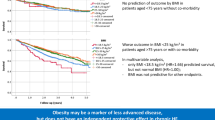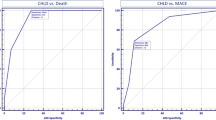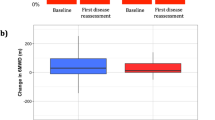Abstract
In chronic heart failure (CHF) due to systemic cardiovascular disease, obese patients have better survival. Bodyweight versus survival was analyzed post hoc in subjects with limited scleroderma (SSc) and isolated pulmonary artery hypertension (PAH), i.e. with CHF due to pulmonary vascular disease. Rheumatologists referred scleroderma subjects for evaluation, and PAH was ascertained by right heart catheterization (RHC). Forty-nine SSc-PAH subjects were stratified by body mass index (BMI): obese 7 (14.3 %), overweight 11 (22.4 %), normal weight 21 (42.9 %), and underweight 10 (20.4 %) for 24-month follow-up and pooled together for long-term 72-month follow-up. Survival was analyzed by Kaplan–Meier method. Multivariate Cox proportional hazards modeling helped to assess variables associated to survival. At 24 months (17 events), survival increases with BMI across four groups (logrank for trend P = 0.031). By Cox multivariate mortality, best model included: BMI (P = 0.043), low lung diffusion (DLco, P = 0.007), and reduced stroke volume index (SVI, P = 0.017). At 72 month (37 events), higher BMI values were associated with better survival but not significantly (P = 0.076). By multivariate modeling BMI did not enter any model, whereas low DLco entered all (P < 0.001). Also low SVI (P = 0.02) and low mixed venous saturation (SvO2, P = 0.009) were associated with the prognosis. From PAH diagnosis to final event, BMI had small (5.4 %), but significant decline (P < 0.001). This is ascribed to CHF progression, and may explain BMI predictive power weakening. The results suggest BMI decline should be contrasted, DLco is useful for screening and with SVI and SvO2 for assessing prognosis and treatment.


Similar content being viewed by others
References
Arena R, Lavie CJ (2010) The obesity paradox and outcome in heart failure: is excess bodyweight truly protective? Future Cardiol 1:1–6
Flegal KM, Graubard BI, Williamson DF, Gailm MH (2005) Excess deaths associated with underweight, overweight, and obesity. JAMA 293:1861–1867
Lavie CJ, Mehra MR, Milani RV (2005) Obesity and heart failure prognosis: paradox or reverse epidemiology? Eur Heart J 26:5–7
Kenchaiah S, Evans JC, Levy D, Wilson PW, Benjamin EJ, Larson MG et al (2002) Obesity and the Risk of Heart Failure. N Engl J Med 347:305–313
Horwich TB, Fonarow GC, Hamilton MA, MacLellan WR, Woo MA, Tillisch JH (2001) The relationship between obesity and mortality in subjects with heart failure. J Am Coll Cardiol 38:789–795
Mehra MR, Uber PA, Park MH, Scott RL, Ventura HO, Harris BC, Frohlich ED (2004) Obesity and suppressed B-type natriuretic peptide levels in heart failure. J Am Coll Cardiol 43:1590–1595
Gustafsson F, Kragelund CB, Torp-Pedersen C, Seibaek M, Burchardt H, Akkan D et al (2005) DIAMOND study group. Effect of obesity and being overweight on long-term mortality in congestive heart failure: influence of left ventricular systolic function. Eur Heart J 26:58–64
Zafrir B, Adir Y, Shehadeh W, Shteinberg M, Salman N, Amir O (2013) The association between obesity, mortality and filling pressures in pulmonary hypertension subjects; the “obesity paradox”. Respir Med 107:139–146
Robbins IM, Moore TM, Blaisdell CJ, Abman SH (2012) NHLBI workshop: improving outcomes for pulmonary vascular disease. Circulation 125:2165–2170
Marini C, Formichi B, Bauleo C, Michelassi C, Pancani R, Prediletto R et al (2014) Improved survival in limited scleroderma-related pulmonary artery hypertension. Intern Emerg Med 9:385–396
Simonneau G, Galiè N, Rubin LJ et al (2004) Clinical classification of pulmonary hypertension. J Am Coll Cardiol 43:5S–12S
Masi AT, Rodnan GP, Medsger TA, Altman RD, Dangelo WA, Fries JF et al (1980) Preliminary criteria for the classification of systemic sclerosis (scleroderma) Subcommittee For Scleroderma Criteria of the American Rheumatism Association Diagnostic and Therapeutic Criteria Committee. Arthritis Rheum 23:581–590. doi:10.1002/art.1780230510
Campo A, Mathai SC, Le Pavec J, Zaiman AL, Hummers LK, Boyce D et al (2010) Hemodynamic predictors of survival in scleroderma-related pulmonary arterial hypertension. Am J Respir Crit Care Med 182:252–260
Mahler DA, Wells CK (1988) Evaluation of clinical methods for rating dyspnea. Chest 93:580–586
Stupi AM, Steen VD, Owens GR, Barnes EL, Rodnan GP, Medsger TA (1986) Pulmonary hypertension in CREST syndrome variant of systemic sclerosis. Arthritis Rheum 29:515–524
Koh ET, Lee P, Gladman DD, Abu-Shakra M (1996) Pulmonary hypertension in systemic sclerosis: an analysis of 17 subjects. British J Rheum 35:989–993
Condliffe R, Kiely DG, Peacock AJ, Corris PA, Gibbs JS, Vrapi F et al (2009) Connective tissue disease-associated pulmonary arterial hypertension in the modern treatment era. Am J Respir Crit Care Med 179:151–157
Hachulla E, de Groote P, Gressin V, Sibilia J, Diot E, Carpentier P et al (2009) Itinér AIR-Sclérodermie Study Group: the three-year incidence of pulmonary arterial hypertension associated with systemic sclerosis in a multicentre nationwide longitudinal study in France. Arthritis Rheum 60:1831–1839
van den Hoogen F, Khanna D, Fransen J et al (2013) Classification criteria for systemic sclerosis: an American College of Rheumatology/European League against Rheumatism collaborative initiative. Arthritis Rheum 65:2737–2747
Altman DG (1991) Practical Statistics for Medical Research: Chapman and Hall, London, p 381
Fox J (2002) Cox proportional-hazards regression for survival data. Appendix to An R and S-PLUS Companion to Applied Regression, Rev. ed. Sage Publications, London, p 1–18
deLeeuw J (1992) Introduction to Akaike: Information Theory and an Extension of the Maximum Likelihood Principle, 1973; Pages 599–09. In: Kotz S and NL Johnson (eds) Breakthroughs in Statistic Volume 1. Foundations and Basic Theory. Springer Series in Statistics, Perspectives in Statistics. Springer-Verlag, New York
Kawut SM, Taichman DB, Archer-Chicko CL, Palevsky HI, Kimmel SE (2003) Hemodynamics and survival in subjects with pulmonary arterial hypertension related to systemic sclerosis. Chest 123:344–350
Fisher MR, Mathai SC, Champion HC et al (2006) Clinical differences between idiopathic and scleroderma-related pulmonary hypertension. Arthritis Rheum 54:3043–3050
Overbeek MJ, Lankhaar JW, Westerhof N et al (2008) Right ventricular contractility in systemic sclerosis-associated and idiopathic pulmonary arterial hypertension. Eur Respir J 31:1160–1166
Benza RL, Gomberg-Maitland M, Naeije R, Arneson CP, Lang IM (2011) Prognostic factors associated with increased survival in subjects with pulmonary arterial hypertension treated with subcutaneous treprostinil in randomized, placebo-controlled trials. J Heart Lung Trasplant 30:982–989
Anker SD, Negassa A, Coats AJ et al (2003) Prognostic importance of weight loss in chronic heart failure and the effect of treatment with angiotensin-converting-enzyme inhibitors: an observational study. Lancet 361:1077–1083
Le Pavec J, Girgis RE, Lechtzin N et al (2011) Systemic sclerosis-related pulmonary hypertension associated with interstitial lung disease: impact of pulmonary arterial hypertension terapies. Arthritis Rheum 63:2456–2464
Le Pavec J, Humbert M, Mouthon L, Hassoun PM (2010) Systemic sclerosis-associated pulmonary arterial hypertension. Am J Respir Crit Care Med 181:1285–1293
Allanore Y, Borderie D, Avouac J et al (2008) High N-terminal pro-brain natriuretic peptide levels and low diffusing capacity for carbon monoxide as independent predictors of the occurrence of precapillary pulmonary arterial hypertension in patients with systemic sclerosis. Arthritis Rheum 58:284–291
Mathai SC, Hassoun PM (2011) Pulmonary arterial hypertension associated with systemic sclerosis. Expert Rev Respir Med 5:267–279
Steen V, Medsger TA Jr (2003) Predictors of isolated pulmonary hypertension in patients with systemic sclerosis and limited cutaneous involvement. Arthritis Rheum 48:516–522
Braunwald E (2001) Hypoxia and cyanosis. Harrison’s principles of internal medicine, 15th edn. McGraw-Hill, New York, pp 214–217
Acknowledgments
The authors thank Drs Renato Prediletto, Simonetta Monti, Giosuè Catapano, and Francesca Mannucci for taking care of the patients.
Author information
Authors and Affiliations
Corresponding author
Ethics declarations
Conflict of interest
The authors declare that they have no conflict of interest.
Statement of human and animal rights
All procedures performed were in accordance with the ethical standards of the institutional and/or national research committee and with the 1964 Helsinki declaration and its later amendments or comparable ethical standards. This article does not contain any studies with animals performed by any of the authors.
Informed consent
Informed consent was obtained from all individual participants included in the study.
Rights and permissions
About this article
Cite this article
Marini, C., Formichi, B., Bauleo, C. et al. Survival protection by bodyweight in isolated scleroderma-related pulmonary artery hypertension. Intern Emerg Med 11, 941–952 (2016). https://doi.org/10.1007/s11739-016-1446-2
Received:
Accepted:
Published:
Issue Date:
DOI: https://doi.org/10.1007/s11739-016-1446-2




